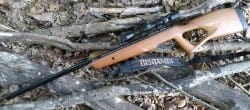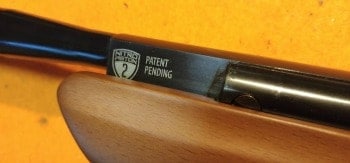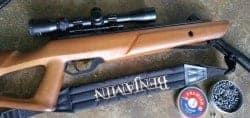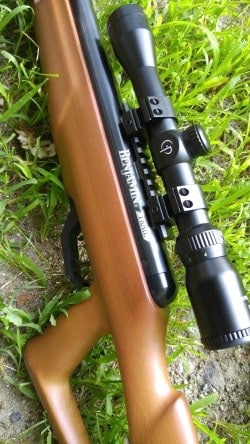I peered through the ocular lens of the scope, reached up with my trigger hand, and cranked the
I could clearly see the offal of the animal’s prey in its mouth, and falling on the ground around the tree, cascading down into a grim pile below. Time stood still as the perfect combination of heartbeats, breath, and trigger pressure coincided, and I clearly recall the magnificent beast, darkly silhouetted in the dappled light of the late afternoon sky. The fierce animal shifted on its perch, muscles tensed, ready to lunge at me, or effect its escape. I squeezed the trigger. I felt it break cleanly beneath the pad of my finger. Perfect.
The calm afternoon couldn’t have been shattered less; the integrally-suppressed barrel of my rifle made a whispered “whap” noise as I sent the projectile hurtling through the crisp winter atmosphere, coursing towards my quarry’s cranium. The soft lead met skin-covered bone with an audible “whack!” and I saw my worthy challenger hunch up on the tree branch and freeze, as if pondering what course of action to pursue next. Gravity and high-velocity lead poisoning joined forces to hasten the animal’s decision-making, and the creature slowly toppled backwards and fell, fell, fell….meeting its ultimate demise upon sudden Earth-induced deceleration. A shower of quills, a final kick, the body relaxed, and it was over….I had prevailed. That was one porcupine that wasn’t going to eat my sugar maples anymore.
The Hunting that slew this particular Grendel’s Mother is a mighty tool indeed – but it’s not a firearm.
SKIP AHEAD
Air-Powered Ecstasy
Aside from the classic Red Ryder carbine action 200-shot range model air rifle with a compass in the
The No products found. is a rifle-sized and -weighted pellet rifle that breaks open at the barrel to load its single shot. Offered in .177” caliber or .22” caliber, the rifle is powerful enough for serious small-game hunting, pest removal, or good old-fashioned plinking.
Also Read: Pellet Guns, Not Just For Kids Anymore
The proudly Made-in-America Trail NP2 utilizes the second generation of Nitro Piston technology (hence the “NP2” moniker) to launch lead, as opposed to springs, CO2 cartridges, pneumatic pump-action, or pre-charged pneumatic (PCP) systems. The Nitro Piston system has a nitrogen-filled cylinder onboard; when the rifle is cocked via the break-open barrel, a piston compresses the nitrogen in the cylinder. Once the trigger is pulled, the compressed nitrogen drives the piston forward. This compresses the air in the chamber – and the pellet rockets out of the bore at a zippy clip, propelled by the blast of compressed air from behind. It’s a great system, and has several advantages over standard spring-powered pellet rifles.
A piston-driven air rifle can be left cocked and ready to go for a long time – days, weeks even – without any fear of a compressed spring losing its power or accuracy or messing with spring harmonics. There are no high-tension parts to wear out; however, it’s recommended you fire and work the piston system every couple months in order that the air rifle’s innards and seals don’t bond or compress semi-permanently. Temperature swings don’t fiddle with Nitro Piston air guns, either.
Related: Why Every Prepper Needs A Pellet Gun
A real benefit to the Nitro Piston system – and the Trail NP2 rifles in particular – is that they are VERY quiet. I’m told spring-powered air rifles can be quite noisy when the springs do their job, but the NP2 system’s nitrogen-powered piston is effortlessly noiseless – the only noise you hear from the rifle is a “whap!” sort of sound – about as loud as a handclap -that emanates from the barrel when the trigger is pulled. It helps that the barrel has an integral “suppressor” of sorts, with the last few inches of tube taken up by baffles that capture the noise of the compressed air being driven from the rifle. While unsuppressed air rifles certainly aren’t exactly like a .30-06 going off in your ear, the sound of compressed air rushing can be quite loud and distinctive-sounding; the baffles at the dangerous end of the No products found. do their intended job very effectively. I was able to do some target practice out the kitchen window this morning with my wife sleeping in the next room – she snoozed like a baby right through the whole process.
The Benjamin Trail NP2 does not have any fixed sights; rather, the rifle comes out of the box with a Picatinny rail mounted to the receiver. A set of inexpensive Weaver-style scope rings and a Centerpoint 3-9x scope make up the sighting package for the Trail NP2. The scope itself is not a high-priced item, especially to a guy who’s used to peering through Leupold and Burris scopes. But for the price point – and considering there is zero recoil for the scope to contend with – the Centerpoint does its job acceptably well. The crosshairs have stadia lines integrated into the reticle – why, I don’t know; you’re not going to be shooting at antelope in a 15mph crosswind 300 yards away with this rifle. But once the ocular-end focus is adjusted, the scope is decently clear and effective. It’s a solid starting point for optics on this rifle, and can be upgraded down the line simply by popping a new scope on the rings.
Rounding out the onboard accessories of the Benjamin Trail NP2 is a rear stock mounted QD sling swivel and a front sling loop for the included nylon padded logo sling. Offered in black synthetic or hardwood, the stock sports a thumbhole stock and a high comb for good cheek weld with optics use. A rubber non-slip recoil pad brings up the tail end of the Trail.
Breaking Bad – in a Good Way
The Benjamin Trail NP2 offers a newly designed “Clean Break Trigger” or CBT in the hopes of maximizing the shooter’s accuracy experience. The CBT is a two-stage affair with a healthy amount of smooth, even take-up – probably a half inch of travel in total. After the initial take-up is pulled through, the rest of the trigger pull is decidedly short and relatively crisp, though with some definite creep. Considering that the Trail NP2 and scope is a $250 retail package, the trigger is quite good – certainly better than most AR-15s or even modern-production .22 rifles.
As a bonus, the trigger is adjustable – according to the instructions that come with the rifle, the trigger pull “second stage length” can be changed by accessing the adjustment screw that resides behind the trigger. Turning the screw clockwise shortens the length of the stage, counterclockwise increases. I fiddled with the settings a bit to make sure it worked, but then I returned the trigger to the factory setting; I was quite happy with it out of the box. Changing the “stage length” isn’t going to turn the trigger into a tuned match affair…but it does offer a bit of adjustability for those who like to tinker with their toys. It’s nice to see some effort by manufacturers put into providing a clean trigger on a rifle like this that’s capable of excellent accuracy.
Don’t Miss: 10 Best Survival Items
The safety is a positive affair, very similar to an M1 Garand. There is a tab inside the trigger guard that slides forward and back; with the tab in the forward position, the gun is ready to fire. In the rearmost position, the tab gets in the way of trigger access, and provides a tactile reminder that the safety is engaged. It works very well, gloves on or off.
Feeding the Beast
As stated, my particular Benjamin Trail NP2 is in .22 caliber – which I find preferable to the .177” for a
That brings us to lead pellets, which is where our looking for serious projectiles begins and ends. There are myriad designs for .22 pellets – domed, hollow point , flat-nosed wadcutter, conical, hybrid lead/polymer, match…the list goes on, and each has its specific usage. Domed, hollow point and conical pellets will penetrate targets more effectively and are best for hunting, while wadcutters are best for accuracy, generally speaking. But realistically, once we find a pellet design or two that works well in our air rifle, there’s no reason to stray. Lay in a healthy stockpile of your chosen pellet, and be happy. Pellets are cheap – The Crosman Ultra Magnum domed pellets my rifle likes are $8.99 for 500 projectiles. Some companies make pellet assortment packs to help you figure out the best projectile for your pellet rifle. Buy, try, then buy more of what your rifle likes best.
Realistic Performance, Not Advertised Performance
As I stated, the Benjamin Trail NP2 .22 air rifle is advertised to push a pellet around 1200 fps. While that may be true with an alloy pellet, I wanted to know what kind of velocities one could actually expect from this rifle utilizing actual useful ammunition. So I dug out my trusty chronograph, and set it up 10 feet from the muzzle when sighting at the bench. I shot ten rounds each of two different types of pellets to see what the performance really was, versus advertised.
The RWS Superpoint Extra Field 14.5 grain pellet showed a low velocity of 743 feet per second (fps), and a high velocity of 770 fps, giving up a spread of just 27 fps. Average was 762.76 fps, resulting in 19 foot-pounds of energy (fpe).
The Crosman Premier Ultra Magnum 14 grain Hunting Pellet uses that half-grain less weight to get a bit more velocity. Low chronographed velocity was 768 fps, with a high speed of 805 fps. This leaves us with a 37 fps deviation, and an average velocity of 768.17 fps for the ten shots fired. This average velocity offers – once again – 19 foot-pounds of energy.
Related: Project Squirrel Gun
In comparison, a .22 Short propels a 29-grain bullet at just over 1,000 fps for 70 foot-lbs of energy, and a .22 Long Rifle varies, but usually offers a bullet in the 40 grain range at about 1150 fps and 117 ft-lbs energy for standard velocity loads.
However, don’t “harumph” away that air rifle’s lower velocity and “only” 19 ft.lbs energy – this rifle is definitely powerful enough to harvest small game and varmints. I’ve sent countless numbers of chipmunks and nuisance red squirrels to the great stuffed cheek gathering grounds in the sky with this Trail NP2. I’ve shot three porcupines and a surprised woodchuck – all good clean kills – with the Trail NP2. A solid hit in the melon at close enough range should easily dispatch anything from small coyote sizes on down…and in a survival situation, I’d definitely see if I could head-shot a deer if the Trail NP2 was all I had to feed my family. I have no doubts that a hit in the head, especially the temple or other soft spot of the skull, could kill or incapacitate a human. This tool is not a toy, by any stretch of the imagination. As with any other firearm, all firearms safety rules definitely still apply to this rifle.
To satiate my own curiosity, I collected some scraps of lumber from my workshop and set them up outside, air rifle and some Crosman Premier Magnum domed pellets in tow. At a distance of five yards, the No products found. sent .22 caliber pellets sailing through ⅝” OSB board, and they completely penetrated every piece of ¾” wood I had – pine, maple, and red oak. 5/4 pine proved to be the rifle’s match, though, but just barely – the pellet stopped just short of breaking through. Friends, that’s pretty decent performance from a projectile that’s pushed by nothing but air.
Accuracy is quite good as well. Resting on my window sill, I can group five pellets into an inch cluster at 30 yards – the length of my backyard. I have found that maintenance plays a big part (whodathunk?), and when my accuracy starts going to pot, I run a .22 caliber bore brush through the rifle a few times and swab out the bore. Accuracy then returns again to normal.
Loves and Hates, Cheers and Jeers
I don’t have much to complain about with the No products found.. My biggest beef is the lack of iron
My other complaint is pure snobbery with a touch of function – the scope. I do realize the rifle needs to be competitive price-wise so the choice of the Centerpoint scope is…tolerable…in that regard. However, I found that modest bumps or bangs will send the scope off zero – not something I find tolerable if my life depends on the rifle. I will be upgrading to Leupold rings and a 2x-7x Leupold Rimfire scope as money allows.
I do love the repeatable accuracy of this rifle (provided the scope isn’t nudged). Once I found a pellet design the rifle liked, the Trail NP2 was a shooting machine. I use the air rifle almost daily to cull nuisance critters from my garden and property, and its works terrifically well for this purpose.
The Nitro Piston design works slick as greased butter, and it’s not terribly difficult to operate. A bit of strength is required to cock the rifle, but a basic understanding of leverage principles and a little bit of practice will counteract that.
I’m also a fan of the included sling mounts. Hell, even a Ruger 10/22 Takedown doesn’t offer sling mounting locations right out of the box. This is a nice touch, and the provided Benjamin sling works well for its intended purpose. I might upgrade it down the road to a leather military sling, but that’s not a huge priority. Being able to carry your rifle slung while hunting or backpacking is a lovely option – especially for an air rifle that’s headed for the eight pound weight range.
The Clean Break Trigger is also a refreshing touch – this air rifle sports a trigger that is better than many stock modern .22 rifles. Thumbs up to Benjamin for providing a product with a decent trigger for those who appreciate the feature and will take advantage of it.
Wrapping It Up
The Benjamin Trail NP2 .22 caliber air rifle is a must-have tool. If you’re a prepper/survivalist, the Trail NP2 offers the ability to (relatively) quietly harvest small game and nuisance animals. Ammunition is very inexpensive, and its small size means you can have a huge quantity of projectiles stashed away without taking up much room.
For the everyday guy, the Benjamin Trail NP2 offers an inexpensive, ridiculously fun method of maintaining your shooting chops and providing pest control. Your neighbors won’t balk when the rifle goes off, you can order ammo off Amazon, and the Trail NP2 technically isn’t a firearm so many gun control laws simply aren’t applicable (depending on jurisdiction – research your laws!)
Overall, the Benjamin Trail NP2 is a dynamite addition to one’s arsenal – and I daresay it would be a fine choice more many who choose to have a one-gun collection. While I don’t think an air rifle could ever supplant a good .22 Long Rifle – especially when ranges are past 50 yards – I do know that I find myself reaching for the Trail NP2 more often than the Ruger 10/22 to complete shootin’ tasks around the homestead. It’s fun, lethal on small game, and supremely practical to own, even if you own a hundred firearms. I don’t want to say you’d be a fool not to have one, but, oh, what the hell – you’d be a fool not to have one.
Questions? Comments? Do you have an air rifle as part of your preps or daily use? Sound off in the comments below!





